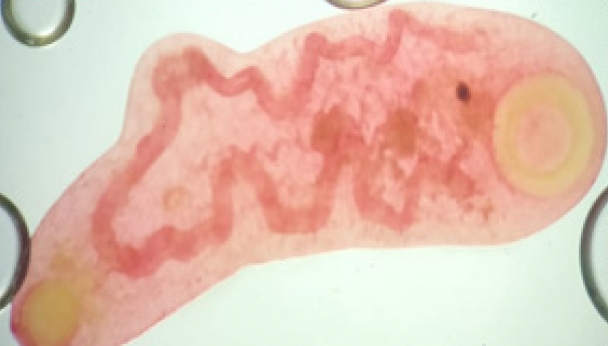Incidence and haematobiochemical study of amphistomosis in buffaloes (Bubalus bubalis) in Mhow, Madhya Pradesh
DOI:
https://doi.org/10.56825/bufbu.2023.4224514Keywords:
Bubalus bubalis, buffaloes, amphistomosis, haematobiochemical, incidenceAbstract
In the present study, samples from 100 buffaloes of either sex were collected from slaughterhouse located at Cantonment Board Mhow for the detection of ruminal amphistomosis. Blood samples with or without anticoagulant were collected to study the haematobiochemical changes in buffaloes suffered from amphistomosis. Amphistomes were also collected for morphological identification of amphistome species in slaughtered animals. The prevalence of ruminal amphistomes was found to be 8%. The infected buffaloes in this study showed a reduction in the mean values of Hb, TEC and PCV. There was an increase in TLC and neutrophil count. Lymphocytes showed a slight decrease in their mean values and no significant changes were seen in values of basophil and eosinophil count. The infected buffaloes in this study showed a reduction in the mean values of total protein. The mean values of SGOT, SGPT and alkaline phosphatase showed an increment in the infected buffalo.
Downloads
Metrics
References
Biswas, A., A. Phukan, C.C. Baruah, S.S. Sarma and P.R. Dutta. 2013. Haematobiochemical changes in cattle with naturally acquired paramphistomiasis. Indian Vet. J., 90(10): 26-28.
Chauhan, V.D., P.V. Patel, J.J. Hasnani, S.S. Pandya, S. Pandey, D.V. Pansuriya and V. Choudhary. 2015. Study on hematological alterations induced by amphistomosis in buffaloes, Vet. World, 8(3):417-420. DOI: 10.14202/vetworld.2015.417-420
Choudhary, V., J.J. Hasnani, P.S. Khyalia, V.D. Chauhan, S.S. Pandya and P.V. Patel. 2015. Morphological and histological identification of Paramphistomum cervi (Trematoda: Paramiphistomum) in rumen of infected sheep, Vet. World, 8(1): 125-129.
Dube, S. and M. Tizauone. 2014. Paramphistomes in Matebeleland south province Zimbabwe and their effect on aspects of blood plasma composition in infected cattle. IOSR Journal of Agriculture and Veterinary Science, 7(2): 133-138. Available on: https://www.iosrjournals.org/iosr-javs/papers/vol7-issue2/Version-1/W0721133138.pdf
Gamit, A.B., P.K. Nanda, R. Bhar and S. Bandyopadhyay. 2017. Explanatum Explanatum infection in the liver of water buffalo. International Journal of Science, Environment and Technology, 6(2): 1231-1235.
Hafeez, M. and A. Usha. 2007. Histochemical and biochemical studies of biliary amphistomosis in buffaloes. Indian J. Anim. Sci., 77(12): 1265-1267.
Hasnani, J.J. 1992. Comparitive studies on the mmunological, histopathological, histochemical and biochemical aspects of Fasciola gigantica and Gigantocotyle explanatum infestation in buffaloes. M.V.Sc. Thesis, Gujarat Agricultural University, Anand, India.
Juyal, P.D., K. Kasur, S.S. Hassan and K. Paramjit. 2003. Epidemiological status of paramphistomiasis in domestic ruminants in Punjab. Journal of Parasitic Diseases, 231-235.
Khan, U.J., A. Tanveer and A. Maqbool. 2008. Epidemiological studies of paramphistomosis in cattle. Veterinary Archive, 78(3): 243-251. Available on: https://hrcak.srce.hr/file/38168
Mavenyengwa, M., S. Mukaratirwa and J. Monard. 2010. Influence of Calicophoron microbothrium amphistomosis on the biochemical and blood cell counts of cattle. J. Helminthol., 84(4): 322-361.
Muhammad, A., S.I. Shah, M.N. Iqbal, S. Ali, M. Irfan, A. Ahmad and M. Qayyum. 2015. Prevalence of Gigantocotyle explanatum in buffaloes slaughtered at Sihala Abattoir, Rawalpindi. J. Zool., 30(1): 11-14. Available on: http://pu.edu.pk/images/journal/zology/PDF-FILES/3-Prevalence%20of%20Gigantocotyle%20explanatum%20in%20buffaloes%20slaughtered%20at%20Sihala%20Abattoir,%20Rawalpindi.pdf
Murthy, C.K. and P.E. D’Souza. 2016. Prevalence of gastrointestinal parasites in bovines in Bangalore district, Karnataka. Journal of Parasitic Diseases, 40(3): 630-632. DOI: 10.1007/s12639-014-0548-x
Nath, R. 2007. Haemato: Biochemical changes in cattle with paramphistomiasis. Indian Vet. J., 84: 1240-1242.
Puttalakshmamma, G.C. 2010. Morphology, pathology and molecular characterization of adults and free living developmental stages of amphistomes of water buffalo (Bubalus bubalis). J. Vet. Parasitol., 24(2): 34-35.
Sahil, K., G. Das, B. Roy, R.N. Katuri, A.K. Singh and S. Nath. 2012. Cost benefit analysis of anthelminthic treatment on milk production in buffaloes. Environment and Ecology, 30(4A): 1538-1540.
Sreedevi, C. and M. Hafeez. 2014. Prevalence of gastrointestinal parasites in buffaloes (Bubalus bubalis) in and around Tirupati, India. Buffalo Bull., 33(3): 251-255. Available on: https://kukrdb.lib.ku.ac.th/journal/BuffaloBulletin/search_detail/result/286487
Swarnakar, G., A. Kumawat, B. Sanger, K. Roat and H. Goswami. 2014. Prevalence of amphistome parasites (Trematoda; Digenea) in Udaipur of southern Rajasthan, India. International Journal of Current Microbiology and Applied Sciences, 3(4): 32-37.
Sykes, A.R. 2008. The effect of subclinical parasitism in sheep. Vet. Res., 102(2): 32-34.
Thakur, R., R. Singh, R.K. Mandial, S. Bala and R. Katoch. 2006. Clinico-haematological, biochemical, minerals and therapeutic studies on amphistomosis in cattle of Himachal Pradesh. Indian Vet. J., 26(1): 5-12.
Varma, Y. and M. Swamy. 2006. Pathology of naturally occurring biliary Amphistomiosis in buffaloes. Indian Journal Veterinary Pathology, 30(2): 62-63.
Verma, S.K., M.P. Gupta and R. Jindal. 2006. Studies on mineral profile in serum of buffaloes infected with paramphistomosis. Journal of Veterinary Parasitology, 20(2): 137-139.









.png)








